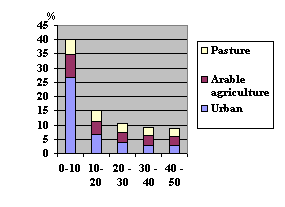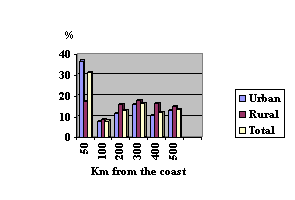3.3 Nature areas
| Ramsar Sites in the BSR |
| |
Number of Ramsar Sites |
Surface area covered (ha) |
Date of signing the convention |
| Belarus |
1 |
19,384 |
1991 |
| Denmark |
38 |
2,283,013 |
1978 |
| Estonia |
10 |
215,950 |
1994 |
| Finland |
11 |
101,343 |
1975 |
| Germany* |
31 |
672,852 |
1976 |
| Latvia |
3 |
43,300 |
1995 |
| Lithuania |
23 |
50,451 |
1993 |
| Norway |
23 |
70,150 |
1975 |
| Poland |
8 |
90,455 |
1978 |
| Russia* |
35 |
10,323,767 |
1977 |
| Sweden |
30 |
382,750 |
1975 |
| * Applies to the whole of the Russian Federation and Germany. |
The BSR has large unspoiled areas with high level of biodiversity. The region has preserved environment and habitats uncommon in more densely populated areas of Europe, such as forests and wetlands with rich biodiversity of flora and fauna. With regards to wetlands the BSR has an important place on a European scale. Largest wetland areas (protected and unprotected) are in Sweden, Norway, Denmark, Estonia and Finland21 . All BSR countries except Belarus have signed the Convention on Wetlands and have areas included in the List of Wetlands of International Importance. Bodies of fresh water are spread all over the northern VASAB area.
Large coastal areas have remained undeveloped and many animal species are still common in Baltic States that are nearly extinct in Western Europe (e.g. wolves, lynx and storks).
Challenges regarding mobility and energy networks
- Promote environment friendly modes of transport;
- Add to transnational infrastructure concepts corridor improvements relevant for regional development and for effective integration across the BSR and across the whole of Europe;
- Support the functionality of ports as transport nodes;
- Promote spatial structures which support public transport and energy efficiency;
- Enhance the formation of a common energy market;
|
Protection of natural areas is an important component of national strategies for conservation and sustainable development. But natural areas cannot be regarded as isolated units. Their functionality depends ecologically, economically, politically and culturally from areas around them22 . Transnationally, protected areas can be connected to constitute green corridors across borders, important corridors for wildlife.
At national level, a variety of designations are used for protected areas. Conditions for the establishment and management of protected areas differ between countries. For the purpose of this report, the focus is on areas that are designated with a national level of protection, were governments have fundamental responsibility for the existence and management of protected areas.
|
Protected areas according to national law, (% of total country' s territory)
|

|
| Source: Baltic State of the Environment, Fammler et al (1998) (table 4.3.1)
|
In Finland, Norway and Sweden, there is a long tradition of national parks that are protected due to valuable nature, landscape or habitats and include high level of protection.
In Finland there are 32 national parks (1.1.1999). Other extensive forms of protection are Protected Mires and strict nature reserves. In addition, there are 12 wilderness reserves preserving the wilderness character of these areas and safeguarding the Sami culture and nature-based forms of livelihood. These areas are not nature reserves in the strict sense and are not included in the statistics.
In Norway there are 18 national parks (1.1.1998) that cover in total area of 13,788 km2. Other forms of protection are landscape protection areas and 1,318 Nature Reserves which represent undisturbed nature or special biotopes being the strictest form of nature protection.
Sweden has 26 national parks. Other large forms of nature protection are Nature Reserves that form 3/4 of protected areas and Nature Protection areas.
Denmark has no national parks, but 101 nature reserve areas (natur og vildtreservater). The largest one (Vadehavet) covers 1140 km2. International protection areas (EU Habitat directive on birds and Ramsar sites) form approximately 2,600 km2, or 6% of total land area. Most protected areas are for coastal and bird protection. Extensive coastal protection is incorporated in the planning legislation. From 1995 the coastal protection strip was extended from 100 m to 300 m
In the Baltic States, the proportion of protected areas have increased significantly in the last 15 years23 and maintenance of biodiversity and landscape has a high priority in their National Environmental Strategies. All Baltic States are currently developing concepts for national ecological networks.
The designation of protected areas in Estonia is regulated by the Act on Protected Natural Objects (1994). Protected areas include 4 national parks, 20 nature reserves and 47 landscape reserves/nature parks. Estonia has the largest proportion of strictly protected areas of the Baltic States. National parks are designated for preservation, protection of cultural heritage. They are divided into strict nature reserves, special management zones and limited management zones. Landscape reserves are areas of natural or cultural heritage value and are created for multiple purposes: nature conservation, cultural or recreational. The preservation of biodiversity, with emphasis on wetlands, and creating networks by improving the links between protected areas are priorities of the Estonian environmental policy.
In Latvia, preservation of biodiversity and characteristic landscapes is an important policy goal. Protected areas form nearly 7% of the territory. They are divided into nature reserves, national parks, biosphere reserves, restricted territories of nature, nature parks, protected landscapes and monuments of nature. State nature reserves form the largest group of protected areas, protected landscape areas and national parks. Latvia's 3 national parks form 16% of nationally protected areas. They allow various activities, including recreation. The environmental policy plan of Latvia aims at improving the network of protected areas and calls for integrated management plans.
In Lithuania protected territories are designated by the "law of protected territories" (1993). They exceed 11% of the total Lithuanian territory (4% in 1995). As of 01.01.2000, they included 6 state reserves (0.4% of total territory), 5 national parks (2.3%), 30 regional parks (6.3%) 352 state and municipal reserves (2.51% of total territory) and 662 protected landscapes.
In Belarus there are four National Parks, covering 3368 km2. There is one biosphere reserve and 99 areas protected because of landscape, biology, hydrology. The 'Polesski radiological ecological preserve' covers 21,550 km2.
In the Kaliningrad Region there are 8% protected natural areas, one with national and seven with regional designation status.
In Poland there are four types of protected areas - national parks, landscape parks, protected landscape and nature reserves. Of the twenty-two national parks in Poland, two are on the Baltic Coast.
In the Baltic Sea regions of Germany, there are different forms of national nature protection - national parks, nature parks, natural protected areas, protected landscapes and wilderness reserves as well as biosphere reserves and wetland protection. 80% of the German Wetlands are located in the BSR. There are thirteen national parks in Germany to "maintain a broad variety of habitats, animals and plants and to support undisturbed development of nature", six of which are located in the BSR.
Protected natural areas in the BSR
Source: Nordregio
Transfrontier Ecosystems and Internationally Adjoining Protected Areas
Transboundary adjoining protected areas in the BSR 24 |
| Countries |
Designated Areas |
IUCN Category |
Belarus/
Poland |
Belovezhskaya Pushcha National Park/
Bialowieski National Park |
II/
II |
Denmark/
Germany |
Waddensee Nature Reserve
Vadehavet Wildlife Reserve
Vadehavet Conservation Area
Vadehavet National Nature Area/
Rantumbecken Nature Reserve
Nord-Sylt Nature Reserve
Holsteinische Schweiz Nature Park
Schleswig-Holsteinisches Wattenmeer National Park
Niedersächsisches Wattenmeer National Park
Dollart Nature Reserve
Nordfriesisches Wattenmeer Nature Reserve |
-
IV
V
IV
IV
IV
V
V
V
IV
IV |
Finland/
Norway |
Lemmenjoki National Park
Øvre Annarjokka National Park |
II
II |
Finland/
Norway |
Käsivarsi Wilderness Area
Reisa National Park
Raisdouttarhaldi Protected Landscape Area |
II
|
Finland/
Norway/
Russian Federation |
Vätsari Wilderness Area
Øvre Pasvik National Park and Reserve
Pasvik Zapovednik |
II
Ia |
Finland/
Russian Federation |
Oulanka National Park
Paanajärvi National Park |
II
II |
Finland/
Russian Federation |
Urho Kekkonen National Park
Laplandskiy Zapovednki |
IV
Ia |
Finland/
Russian Federation |
Friendship Nature Reserve, Kainuu Park
Elimyssalo Nature Reserve
Lentua Nature Reserve
Ulvinsalo Strict Nature Reserve
Juortansalo-Lapinuo Protected Mire
Isosuo-Saarijärvi Protected Mire
Iso-Palonen & Maariansarkät Nature Reserve
Kostomukshskiy Zapovednik (Friendship Nature Reserve) |
Ia
IV
IV
Ia |
Finland/
Sweden |
Perämeri National Park
Haparanda Archipelago National Park
Haparanda-Sandskär Nature Reserve
Haparanda Skärgård National Park |
II
Pr
IV
II |
Lithuania/
Russian Federation |
Kursiu Nerija National Park/
Kurshskaya Kosa National Park |
II
II |
Norway/
Sweden |
Rago National Park
Tysfjord Hellemobotn National Park
Padjelanta National Park
Sarek National Park
Stora Sjöfallet National Park
Sjaunja Nature Reserve
Femundsmarka National Park
Femundsmarka Protected Landscape Area
Gutulia National Park
Rogen Nature Reserve
Rogen-Langfjellet National Park
Tofsingdalen National Park
Lundsneset Nature Reserve
Tresticklan National Park |
II
Pr
II
II
V
Pr
II
V
II
IV
Pr
Ia
|
Ecosystems are often fragmented by boundaries, which can threaten the survival of species and ecosystems. Conservationists emphasise the im-portance of larger-scale ecosystems-based management and regional approach. This is increasingly also recognised by politicians and policy makers.
A global list of Adjoining Protected Areas assembled by the WCMC/IUCN includes only sites where existing protected areas actually adjoin across international boundaries25. In order to meet this criterion, a protected are must be so designated by national government and must cover at least 1,000 hectares. Many complexes of smaller sites are therefore not included.
In some of those areas specific management plans are being prepared, such as Integrated Coastal Management Plans on the western Latvian and Lithuanian coast con-necting with the Kaliningrad region. There has been also co-operation between Lithuanian and Polish authorities on the development of the border region.
EU's network of protected areas, Natura 2000, is being implemented in the EU countries of the BSR.
The BSR boasts of high environmental quality, diverse wildlife, extensive protected areas and wetland and wilderness areas that do not exist in many European countries.
Although the effects of development are not as severe in the BSR as in many other areas of Europe, new development is likely to pose pressure on natural areas, especially in the eastern part of the BSR and in coastal areas.
|
Land Use as a Function of Distance from the Coast in the Drainage Basin
|
Population as a Function of Distance from the Coast in the Drainage Basin
|

|

|
| Source: Nordregio
|
A major threat to the natural heritage, habitat and ecosystems is the spatial fragmentation of protected areas by national and administrative boundaries. The effectiveness of natural conservation in protection areas is highly dependent on the appropriate management of the surrounding areas.
Economic convergence in the BSR: increase in consumption and resumption of industrial activities and growth in private car ownership can lead to increased energy demand and pose pressures on land-use and natural environment. Balance between nature protection and utilising the economic potential of those areas needs to be sought.

